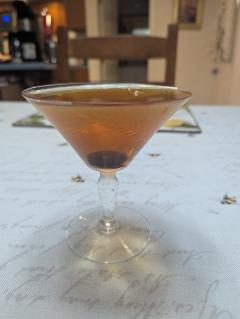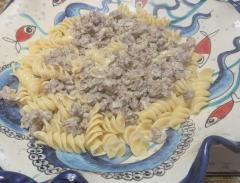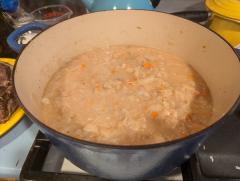 In May and June of 2024, we explored Prague, Vienna, Salzburg, Venice, Sorrento, and all the parts of Italy that we had not yet explored, except Sardinia. It was the biggest and final of three grand vacations that I had been planning since 2020.
In May and June of 2024, we explored Prague, Vienna, Salzburg, Venice, Sorrento, and all the parts of Italy that we had not yet explored, except Sardinia. It was the biggest and final of three grand vacations that I had been planning since 2020.
This trip was extraordinarily productive on the foodie front, including a number of discoveries made and resolved on the trip. I had spent months researching the foodways of each location that we visited, but there were still surprises that I learned of for the first time and then learned enough about to report on.
This article is the entry point to 23 pages that describe the trip day by day. At the bottom of each page you can click forward or back a day, or jump to any of the 23 pages in this journal.

 It started with a chance comment from my friend Bryan that his knowledge of food in the Slavic countries north of the Middle East was limited, and that as far as he knew the people of Russia silently starved. I was in the room, and our friend John Morse was there as well. As I prepared a reply, John quickly said that there a lot of really interesting Russian food and that Bryan and his wife should have a Russian feast at my house!
It started with a chance comment from my friend Bryan that his knowledge of food in the Slavic countries north of the Middle East was limited, and that as far as he knew the people of Russia silently starved. I was in the room, and our friend John Morse was there as well. As I prepared a reply, John quickly said that there a lot of really interesting Russian food and that Bryan and his wife should have a Russian feast at my house! It took a few weeks, but we finally did it last night, 17 November 2024. Guests were Bryan Gregory and his wife Bridget, and our friends Don Nicholson and his wife Jen. Don and I have known each other for 25 years, but this was his first feast at our house.
It took a few weeks, but we finally did it last night, 17 November 2024. Guests were Bryan Gregory and his wife Bridget, and our friends Don Nicholson and his wife Jen. Don and I have known each other for 25 years, but this was his first feast at our house. This golden oldie was invented in the 1890s by the early master Harry Johnson, and freshened up a century later by modern cocktail engineer and historian Dale DeGroff.
This golden oldie was invented in the 1890s by the early master Harry Johnson, and freshened up a century later by modern cocktail engineer and historian Dale DeGroff.  This is a delicious sauce made with cream and pork sausage. The town of Norcia in mountainous southeastern Umbria is renowned for its pork products, and it is the source of this simple and delicious recipe. The town is Norcia, and the sauce made in the style of Norcia uses the adjectival form Norcina, with the extra "n".
This is a delicious sauce made with cream and pork sausage. The town of Norcia in mountainous southeastern Umbria is renowned for its pork products, and it is the source of this simple and delicious recipe. The town is Norcia, and the sauce made in the style of Norcia uses the adjectival form Norcina, with the extra "n". Lasagna is a wonderful Italian dish, an opportunity for all sorts of creativity, but there are two especially classic lasagna recipes that you should know about: this Lasagna alla Bolognese, and the Lasagna Napoletana. The Neapolitan version includes sausage and meatballs, fresh mozzarella and ricotta, it's quite a complex production! The Bolognese version is far simpler, just lasagna noodles,
Lasagna is a wonderful Italian dish, an opportunity for all sorts of creativity, but there are two especially classic lasagna recipes that you should know about: this Lasagna alla Bolognese, and the Lasagna Napoletana. The Neapolitan version includes sausage and meatballs, fresh mozzarella and ricotta, it's quite a complex production! The Bolognese version is far simpler, just lasagna noodles,  This is a primo version of the classic Trieste dish Scampi alla Busara, but the traditional scampi (langoustines) are hard to come by in New England, and when made with shrimp it's a great pasta-topper!
This is a primo version of the classic Trieste dish Scampi alla Busara, but the traditional scampi (langoustines) are hard to come by in New England, and when made with shrimp it's a great pasta-topper! Despite its name proclaiming a Genoese origin, this delicious Neapolitan pasta sauce, a cousin of the French soubise onion sauce, is unknown in Genoa today. It is thought to have been brought to Naples by sailors from Genoa long ago, and to have survived in the south long after it faded into obscurity in the north.
Despite its name proclaiming a Genoese origin, this delicious Neapolitan pasta sauce, a cousin of the French soubise onion sauce, is unknown in Genoa today. It is thought to have been brought to Naples by sailors from Genoa long ago, and to have survived in the south long after it faded into obscurity in the north. This is not a vegetarian recipe. A beef roast cooks with the onions, flavoring them, but it is not served in the sauce or with the pasta at all. In Italy it's traditional to have a simple pasta course before a main course, the primo before the larger secondo. At a fine dinner, you would expect a small dish of pasta with one of the many wonderful sauces (ragu, sugo, salsa) invented for the purpose. A heaping plate of spaghetti is what you eat when you can't afford the secondo course.
This is not a vegetarian recipe. A beef roast cooks with the onions, flavoring them, but it is not served in the sauce or with the pasta at all. In Italy it's traditional to have a simple pasta course before a main course, the primo before the larger secondo. At a fine dinner, you would expect a small dish of pasta with one of the many wonderful sauces (ragu, sugo, salsa) invented for the purpose. A heaping plate of spaghetti is what you eat when you can't afford the secondo course. This is the classic Italian meat sauce, with an official recipe approved by the Accademia Italiana della Cucina and recorded with the Bologna Chamber of Commerce. The recipe gets updated every few generations to account for the changing availability of ingredients, and importantly, to note which popular variations that have arisen are incompatible with the Accademia's focus on authenticity and quality (for example, using cream instead of milk, or brandy instead of dry wine).
This is the classic Italian meat sauce, with an official recipe approved by the Accademia Italiana della Cucina and recorded with the Bologna Chamber of Commerce. The recipe gets updated every few generations to account for the changing availability of ingredients, and importantly, to note which popular variations that have arisen are incompatible with the Accademia's focus on authenticity and quality (for example, using cream instead of milk, or brandy instead of dry wine). This French trout dish is easy to prepare and you can have it on the table in half an hour. Besides the fish, it uses only 5 ingredients that you probably have in the house already, so it's a good recipe to know if you're sometimes lucky enough to get fresh trout!
This French trout dish is easy to prepare and you can have it on the table in half an hour. Besides the fish, it uses only 5 ingredients that you probably have in the house already, so it's a good recipe to know if you're sometimes lucky enough to get fresh trout! Here's another unexpected and delicious flavor combination from Italy, somewhat Americanized. The original Italian recipe, gamberoni all'arancia in padella, used olive oil instead of butter, used bigger shrimp, it skipped the brief marination step, and it did not include the orange zest. I tried it that way first, but then I did it this way and we both liked it better. I think the shredded orange zest makes it more pretty, too.
Here's another unexpected and delicious flavor combination from Italy, somewhat Americanized. The original Italian recipe, gamberoni all'arancia in padella, used olive oil instead of butter, used bigger shrimp, it skipped the brief marination step, and it did not include the orange zest. I tried it that way first, but then I did it this way and we both liked it better. I think the shredded orange zest makes it more pretty, too. This is a staple of children's menus but it's also a delightful primo course when made with good ingredients and fresh gnocchi, and it's vegetarian, too! Kids like it because it has no garlic or onion, but top-quality ingredients really shine, like bright sunny Sorrento in the summer!
This is a staple of children's menus but it's also a delightful primo course when made with good ingredients and fresh gnocchi, and it's vegetarian, too! Kids like it because it has no garlic or onion, but top-quality ingredients really shine, like bright sunny Sorrento in the summer!  The Clafoutis Limousin, or cherry clafoutis, is the best known of this traditional and simple dessert style. It can also be made apples, pears, plums, or berries. If a menu says only Clafoutis (also spelled clafouti), they mean the cherry version.
The Clafoutis Limousin, or cherry clafoutis, is the best known of this traditional and simple dessert style. It can also be made apples, pears, plums, or berries. If a menu says only Clafoutis (also spelled clafouti), they mean the cherry version. The flamiche is a leek quiche. It's a mild dish because the oniony leeks are first stewed until they are tender. Some cheese enriches the flavor while keeping this quiche suitable for vegetarians.
The flamiche is a leek quiche. It's a mild dish because the oniony leeks are first stewed until they are tender. Some cheese enriches the flavor while keeping this quiche suitable for vegetarians. In New England, rutabaga is often called turnip, which is a related but different vegetable. This is the most common preparation, often to accompany a Sunday roast beef or chicken during cold-weather months. In general, turnips are smaller, whiter inside, and often sweeter, while rutabagas are often bigger, yellower inside, and they usually have more of a kind of bitterness that complements a rich dinner.
In New England, rutabaga is often called turnip, which is a related but different vegetable. This is the most common preparation, often to accompany a Sunday roast beef or chicken during cold-weather months. In general, turnips are smaller, whiter inside, and often sweeter, while rutabagas are often bigger, yellower inside, and they usually have more of a kind of bitterness that complements a rich dinner. I make this at least monthly. It's quick, easy, and delicious. The cornmeal brings an exciting flavor and texture that's a nice change from the usual seasoned flour dredge.
I make this at least monthly. It's quick, easy, and delicious. The cornmeal brings an exciting flavor and texture that's a nice change from the usual seasoned flour dredge.